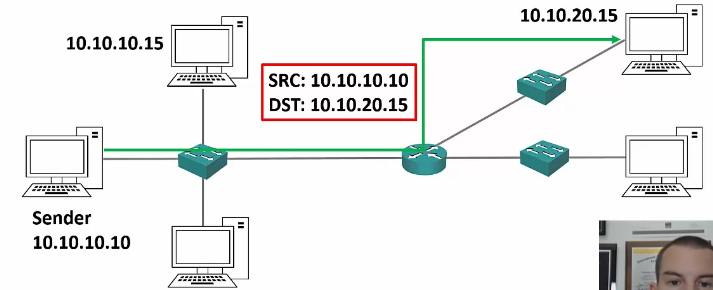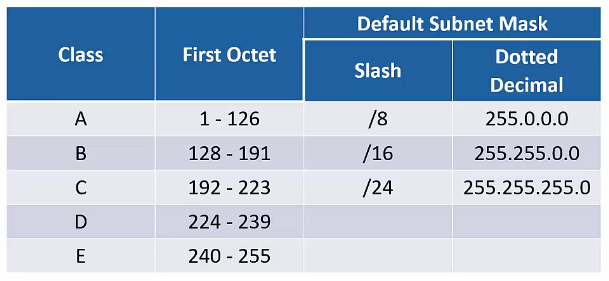< Section 6 | Home | Section 8 >
17% Complete
34: Introduction
35: Class A IP Addresses
https://www.udemy.com/cisco-icnd1/learn/lecture/8589490#content
Subnet Size
- The bigger the host portion of a network, the more hosts you can have
- If the subnet mask is /8, you have 24 bits remaining to allocate to hosts.
- Not a lot of networks, but a lot of hosts
- if the subnet mask is /24, you only have 8 bits remaining to allocate to hosts.
- Not a lot of hosts, but a lot of networks.
- If the subnet mask is /8, you have 24 bits remaining to allocate to hosts.
IANA – Internet Assigned Numbers Authority
- Originally IPv4 was designed to handle all IP requests. Each PC/Workstation could have it’s own IP.
- Unfortunately, the Internet exploded and IPv6 was designed to handle this load.
Class A addresses
- Class A networks are assigned to networks with a very large number of hosts.
- The High-order (first bit) in a Class A address is always set to Zero
- 01111110 00000000 00000000 00000000
- The default subnet mask is /8 (255.0.0.0)
- Valid network addresses range from 1.0.0.0 to 126.0.0.0/8
- This allows for 126 networks and 16,777,214 hosts per network.
Reserved Class A Addresses
- 0.0.0.0/8 signifies “this Network”
- 0.0.0.1 to 0.255.255.255 are not valid host addresses
- 127.0.0.0/8 in the Class A space is reserved as the loopback address for testing the local computer
- 127.0.0.1 – 127.255.255.255 are not valid host addresses
- You should always be able to ping 127.0.0.1 to verify your TCP/IP is working.
- You could also ping any IP in the 127.0.0.1 – 127.255.255.254 and get the same results.
- The combination of these two wiped out 33,445,428 addresses from the global address pool!
Subnetting
- A company with a Class A network would NOT simply assign all 16,777,214IPs directly to hosts with a single network.
- Instead, the would break the network down in to smaller ‘subnets’
- 15.0.0.0/8
- 15.0.1.0/24 could be used in NY
- 15.0.2.0/24 could be assigned to Boston
- 15.0.3.0/24 to Milwaukee …
- 15.0.0.0/8
36: IP Address Classes B and C
https://www.udemy.com/cisco-icnd1/learn/lecture/8589502#content
Class B
- First 2 bits will always be ’10’
- Default mask is /16 (255.255.0.0)
- Network ranges are between 128.0.0.0/16 to 191.255.0.0/16
- 128: 1000 0000
- 191: 1011 1111
- This allows for 16,384 networks and 65,534 hosts per network
- This would also be subnetted in the real world
Class C
- First 3 bits are ‘110’
- Default mask is /24
- Valid ranges are from 192.0.0.0/24 to 223.255.255.0/24
- 192: 1100 0000
- 223: 1101 1111
- This allows for 2,097,152 networks and 254 hosts per network
- This could be allocated as is in the real world or subnetted if required.
Private Addresses
Private Addresses are NOT routeable to the Internet and were originally intended for use in closed private networks.
- Class A: 10.0.0.0 to 10.255.255.255
- Class B: 172.16.0.0 – 172.31.255.255
- Class C: 192.168.0.0 tp 192.168.255.255
37: IP Address Classes D and E
https://www.udemy.com/cisco-icnd1/learn/lecture/8589506#content
Class D
- Class D addresses are reserved for IP Multicast addresses.
- The first 4 bits are ‘1110’
- These addresses are not allocated to hosts and there is no default subnet mask
- Valid ranges are 224.0.0.0 – 239.255.255.255
Multicast
Unicast Overview
- Each packet must be uniquely delivered to each receiving host
Multicast Overview
- Packet is only delivered once and is received by whomever wants it.
- Traffic is actually sent to IP 239.0.0.1 (or similar)
Class E – Experimental
- First 4 bits are ‘1111’
- The addresses are not allocated to hosts and there is no default subnet. mask.
- Addresses range from 240.0.0.0 to 255.255.255.255
- 255.255.255.255 is the broadcast address for ‘this network’
Class Summary
Exam Topic!



